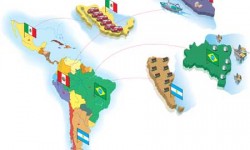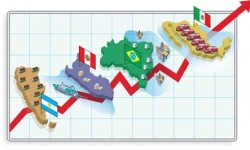Fiscal sense – South America survives the crisis
Summary
It comprises Argentina, Bolivia, Brazil, Chile, Colombia, Ecuador, French Guiana, Guyana, Paraguay, Peru, Suriname, Uruguay and Venezuela.
The main industries are agriculture, fishing, petrochemicals and automotive.
The population is more than 380 million (the population of Latin America, which also includes Mexico, Central America and the Caribbean nations, is more than 570 million).
Brazil, with 191 million inhabitants, is by far the biggest country; in 2008 it had a GDP of 1,610 billion US dollars (1,265 billion euros) according to the World Bank.
A growing middle class, solid democracies, free market economies and diverse trading partners have turned South America into a growth engine for the world.
Currency runs, corruption, inflation, debt defaults, bankrupt central banks, military juntas and coups d’état used to be standard phrases when describing South America. But times have changed.
Today, South America consists of 13 almost-tiger economies that have weathered the stress test of the current global economic downturn through sound fiscal and democratic policies.
While it is not rosy all over South America – Venezuela devalued its bolivar amid rising inflation and was on the brink of war with Colombia in early 2010 – other resource-rich nations such as Brazil, Argentina, Chile and Peru have been growing between 4 and 9 percent a year since 2004, according to the CIA World Factbook.
Once a dictatorship, Chile has embraced market policies and democratic reforms, making it a model for developing countries. And it was the first South American country to join the OECD (the Organisation for Economic Cooperation and Development) in January 2010, becoming the 31st member of this half-century-old club of rich nations. Brazil and China have yet to be invited for membership.
“The economic outlook for South America is much better today than it was in the ’80s, what economists call ‘the Lost Decade’,” says Jeff Dayton Johnson, senior economist and head of the Americas desk at the OECD in Paris.
“The economies in the region are more open to trade and capital flows and are exposed to the world economy in general, which is not necessarily a recipe for vulnerability. In fact, economies that are integrated into the global system are also more resilient in the face of a global downturn.”
In economic circles, it has often been said “When the United States sneezes, Latin America catches a cold.” This happened in the early ’80s when the US recession spread throughout the region, leading to a severe debt crisis that stumped potential growth.
Today, in the face of a global economic crisis that some compare to the Great Depression, analysts are optimistic that history will not repeat itself.
One reason is the increasing growth of bilateral trade between South America and Asia – to feed Asia’s demand for raw materials and to provide South America’s burgeoning middle class with manufactured products.
“South American countries have a much wider base of trade than they have ever had in the past, with many more destinations [besides the US], including China, Japan and Korea, and in general, there are solid democracies in most places. The concept of a capitalistic free market economy has taken hold and is widely accepted,” says Douglas Smith, regional head of research, the Americas, Standard Chartered Bank in New York.
The region has gotten its fiscal houses in order, says Pamela Cox, vice-president Latin America and Caribbean Region at the World Bank in Washington, DC.
“In the past, external shocks spread quickly through much of the region, causing rapid currency devaluation and rising inflation and leaving the poor much worse off,” she says. “But the region learned from past crises. The most striking evidence of this newly gained resilience is the relatively better performance of South America during the global financial crisis compared with Eastern Europe and East Asia. At the same time, this typically middle-income region managed to lift 60 million people from poverty between 2002 and 2008.”
Depending upon which organization one listens to – the OECD, the UN, the World Bank or Fitch Ratings – and whether the numbers are for South America or Latin America as a whole (which consists of South and Central America, Mexico and the Caribbean nations), the region will see GDP growth of between 3 and 4 percent in 2010, following the 2 percent contraction it experienced in 2009.
But most analysts agree that the continent is well positioned for recovery and could contribute to the world’s turnaround and emerge as an even more
attractive destination for investment than it is today.
“The global financial crisis did not originate in Latin America, a region that is sound, liquid and solvent,” Ricardo Marino, president of the Latin American Federation of Banks, told Economics Week in October 2009.
According to a Goldman Sachs study of emerging economies, by 2050 two of the world’s largest economies will be in Latin America – Brazil and Mexico. They will join China, the US and India. In 2009, Brazil was the seventh-largest economy in the world.
But given all the good news and fiscal housecleaning, it is not likely that we will see a full-fledged European Union-type organization in South America to promote trade between member countries.
Some organizations are already established, such as Mercosur and the Andean Community of Nations, but according to Douglas Smith of Standard Chartered Bank, countries have historically had trouble letting others take charge.
“South American countries have a tendency to make more outward ties rather than strengthening the ties among themselves,” he says.
But Venezuelan President Hugo Chavez is still trying. In August 2008, he suggested an ambitious idea: to build a 6,200-kilometre train line between Caracas, Venezuela, and Buenos Aires, Argentina. It is still in the planning stages.
Regional challenges
Jeff Dayton Johnson, senior economist and head of the Americas desk at the OECD, points to some of the challenges in the region:
-
Focus on factors that make the economy more resilient.
-
Make exports more important to growth.
-
Diversification of the set of export countries, and diversification of the products as well.
Despite improvements in macro-economic fundamentals and the quality of economic governance across South America, some challenges remain, says Douglas Smith, regional head of research, Americas, Standard Chartered Bank.
They include:
-
Income inequality
-
Extreme poverty
- Problems with infrastructure.



